 |
 |
 |
| |
Phase II Study of the Safety and Efficacy of New CCR5 Drug Vicriviroc (VCV) in HIV+ Treatment-Experienced Subjects: 48-week Results - ACTG 5211
|
| |
| |
Reported by Jules Levin
4th IAS Conference
22-25 July, 2007
Sydney, Australia
Roy Gulick, MD
Cornell University
for the A5211 Protocol Team
AUTHOR CONCLUSIONS:
In treatment-experienced pts:
--Following optimization of background ART, VCV (10 or 15 mg, with RTV) demonstrated sustained antiretroviral activity over 48 weeks.
--Co-receptor change documented in about 1/3 of subjects on VCV at virologic failure.
Vicriviroc (VCV) was generally well tolerated.
The relationship of VCV to malignancy remains uncertain.
Longer-term follow-up continues.
STUDY DESIGN
Study objective: To evaluate the safety, tolerability and antiretroviral activity of a VCV-containing regimen.
Study population:
ART-experienced adults
HIV RNA >5000 copies/ml on a RTV-containing regimen
R5 phenotype (Trofile assay)
Stratified by:
--enfuvirtide use; baseline CD4 < or >50 cells/μL
Patients added one of 4 arms regimen for 14 days and then optimized therapy regimen. The 5mg arm was discontinued by DSMB.
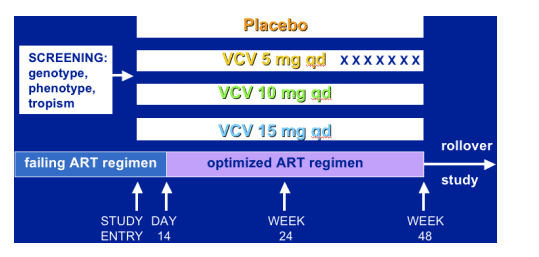
--All regimens included 100-800 mg RTV
--Virologic failure: confirmed less than 1 log10 reduction in HIV RNA at >16 wks
--Cross-over option to VCV following virologic failure
BASELINE & DISPOSITION
Baseline characteristics:
--N = 118 subjects
--median age 46; 92% men, 8% women
--20% black, 12% Hispanic, 66% white, 2% other
--33% were ENF-experienced
--Median HIV RNA 36380 cps/ml; CD4 146 cells/μL
--100% had R5 virus at screening
Disposition (through 48 weeks):
Study treatment discontinued early: 82% (PBO), 30% (10 mg), 37% (15 mg)
Virologic failure: 86% (PBO), 27% (10 mg), 33% (15 mg)
Median Change in HIV RNA (log10 cps/ml; ITT)
About 2 log reduction by 8 weeks, and after 48 weeks viral load reduction was about 1.5 log in 15mg arm and 1.9 log in 10mg arm.
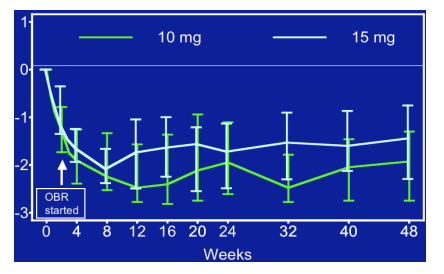
Proportion with
HIV RNA <50 cps/ml
In the 10mg arm about 50% of patients achieved <50 c/ml at week 32, and at week 48 about 40% had <50 c/ml. In the 15mg arm about 30% achieved <50 c/ml at week 40 and the percent declined a bit at week 48.
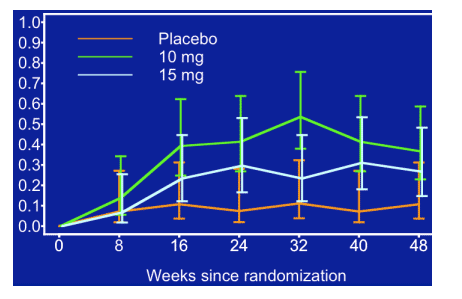
Median Change in
CD4 Cell Count (ITT)
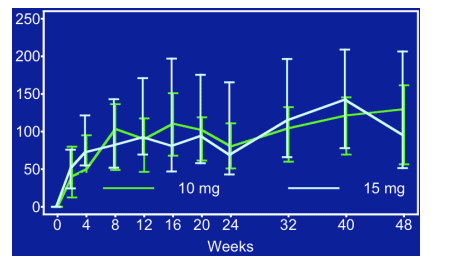
Week-48 Virologic Response for VCV (10 and 15 mg) by Enfuvirtide Use
Patients were not randomized to ENF or not, and the number of patients in this analysis is small. Patients receiving Fuzeon naively (n=12) had a larger reduction in viral load, about -2.5 log, compared to patients who did not receive Fuzeon (-1.7 log).
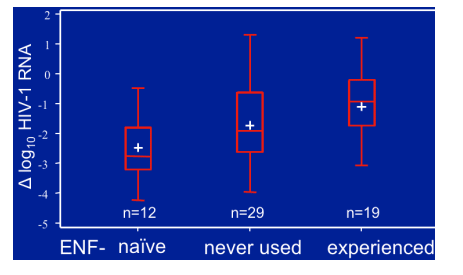
TROPISM
Screening: 118 (100%) with R5 virus
Study entry: 102 (86%) with R5 virus,
--12 (10%) dual/mixed, 4 (4%) missing
On study rx (n=106 with R5 or missing)
18 subjects changed tropism:
--3 on PBO (2 following crossover to VCV)
--15 on VCV: 8 (5 mg), 4 (10 mg), 3 (15 mg)
Of 26 subjects with R5 virus on VCV who experienced virologic failure, 9 (35%) had D/M or X4 virus.
Time to Virologic Failure on VCV by Baseline Tropism (at study entry)
There is a shorter time to failure by D/M then R5 patients, the number of patients is small.
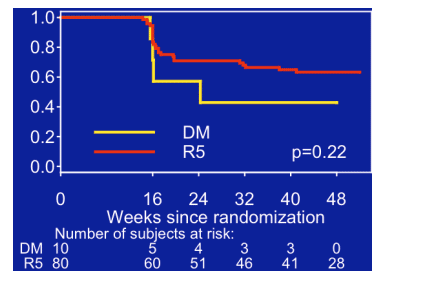
Median Change in HIV RNA and CD4 after Tropism Change on VCV
VL & CD4 donŐt change after tropism switch, the number of patients is small.
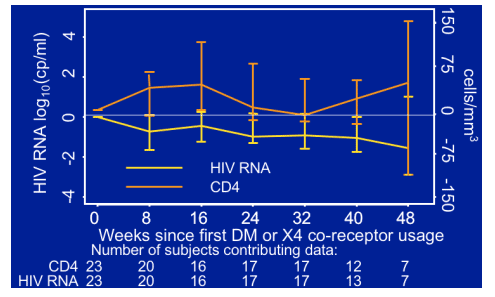
ADVERSE EVENTS
No significant difference for grade 3 or 4 adverse events among 4 arms
(pairwise comparisons, p>0.6)
No seizures reported
Malignancies:
8 subjects randomized to VCV (through 48 wks or on rollover study)
--6 previously reported at 24 weeks: NHL X 2; HodgkinŐs disease X 2; gastric adenocarcinoma; SCC
--Basal cell carcinoma (VCV 10 mg)
--KS recurrence (VCV 5 mg)
2 subjects randomized to PBO, both previously reported at 24 weeks:
SCC X 2 (one on VCV 10 mg X 3 months)
|
| |
|
 |
 |
|
|